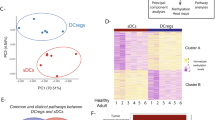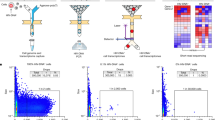Abstract
The repeat region of DC-SIGNR (CD209L) is polymorphic on the genomic level, and, in a separate study, we observed a correlation between the DC-SIGNR genotype and HIV-1 susceptibility during sexual contact. However, previous investigations using immunohistochemistry failed to detect membrane-bound DC-SIGNR on cells in the genital and rectal mucosa. We therefore explored the presence of DC-SIGNR in these compartments with a more sensitive limiting dilution RT-PCR, which also allowed for quantification of alternatively spliced mRNA isoforms. DC-SIGN (CD209) and DC-SIGNR mRNA transcript isoforms were found in all 12 vaginal and two rectal biopsies obtained from 14 healthy individuals. For DC-SIGNR, we detected significantly more isoform than full-length transcripts (mean copy numbers/μg RNA: 602 vs 26; P=0.0009). Four mucosal samples lacked full-length DC-SIGNR transcripts entirely. Cloning and sequencing of DC-SIGNR mRNA in three additional individuals revealed a diverse repertoire of DC-SIGNR isoforms, many of which encoded for proteins predicted to be soluble and secreted. Indeed, in one vaginal sample, we detected only soluble isoforms. In conjunction with our prior observation that the DC-SIGNR genotype has an effect on HIV-1 transmission in vivo, these findings emphasize that DC-SIGNR, in addition to DC-SIGN, should be considered as a cofactor in sexual HIV-1 transmission. Soluble isoforms, in particular, may modulate the efficiency of viral transmission and dissemination.
Similar content being viewed by others
Log in or create a free account to read this content
Gain free access to this article, as well as selected content from this journal and more on nature.com
or
References
Geijtenbeek TB, Kwon DS, Torensma R et al: DC-SIGN, a dendritic cell-specific HIV-1-binding protein that enhances trans-infection of T cells. Cell 2000; 100: 587–597.
Sol-Foulon N, Moris A, Nobile C et al: HIV-1 Nef-induced upregulation of DC-SIGN in dendritic cells promotes lymphocyte clustering and viral spread. Immunity 2002; 16: 145–155.
Kwon DS, Gregorio G, Bitton N, Hendrickson WA, Littman DR : DC-SIGN-mediated internalization of HIV is required for trans- enhancement of T cell infection. Immunity 2002; 16: 135–144.
Pohlmann S, Baribaud F, Lee B et al: DC-SIGN interactions with human immunodeficiency virus type 1 and 2 and simian immunodeficiency virus. J Virol 2001; 75: 4664–4672.
Jameson B, Baribaud F, Pohlmann S et al: Expression of DC-SIGN by dendritic cells of intestinal and genital mucosae in humans and rhesus macaques. J Virol 2002; 76: 1866–1875.
Soilleux EJ, Morris LS, Leslie G et al: Constitutive and induced expression of DC-SIGN on dendritic cell and macrophage subpopulations in situ and in vitro. J Leukoc Biol 2002; 71: 445–457.
Sanders RW, de Jong EC, Baldwin CE, Schuitemaker JH, Kapsenberg ML, Berkhout B : Differential transmission of human immunodeficiency virus type 1 by distinct subsets of effector dendritic cells. J Virol 2002; 76: 7812–7821.
Turville SG, Cameron PU, Handley A et al: Diversity of receptors binding HIV on dendritic cell subsets. Nat Immunol 2002; 3: 975–983.
Baribaud F, Pohlmann S, Leslie G, Mortari F, Doms RW : Quantitative expression and virus transmission analysis of DC-SIGN on monocyte-derived dendritic cells. J Virol 2002; 76: 9135–9142.
Curtis B, Scharnowski S, Watson A : Sequence and expression of a membrane-associated C-type lectin that exhibits CD4-independent binding of human immunodeficiency virus envelope glycoprotein gp120. Proc Natl Acad Sci USA 1992; 89: 8356–8360.
Bashirova AA, Geijtenbeek TBH, van Duijnhoven GCF et al: A Dendritic cell-specific intercellular adhesion molecule 3-grabbing nonintegrin (DC-SIGN)-related protein is highly expressed on human liver sinusoidal endothelial cells and promotes HIV-1 infection. J Exp Med 2001; 193: 671–678.
Pohlmann S, Soilleux EJ, Baribaud F et al: DC-SIGNR, a DC-SIGN homologue expressed in endothelial cells, binds to human and simian immunodeficiency viruses and activates infection in trans. Proc Natl Acad Sci USA 2001; 98: 2670–2675.
Feinberg H, Mitchell DA, Drickamer K, Weis WI : Structural basis for selective recognition of oligosaccharides by DC-SIGN and DC-SIGNR. Science 2001; 294: 2163–2166.
Soilleux EJ, Morris LS, Rushbrook S, Lee B, Coleman N : Expression of human immunodeficiency virus (HIV)-binding lectin DC-SIGNR: consequences for HIV infection and immunity. Hum Pathol 2002; 33: 652–659.
Soilleux EJ, Barten R, Trowsdale J : Cutting edge: DC-SIGN; a related gene, DC-SIGNR; and CD23 form a cluster on 19p13. J Immunol 2000; 165: 2937–2942.
Mummidi S, Catano G, Lam L et al: Extensive repertoire of membrane-bound and soluble DC-SIGN1 and DC- SIGN2 isoforms: inter-individual variation in expression of DC-SIGN transcripts. J Biol Chem 2001; 276: 33196–33212.
Liu H, Hwangbo Y, Holte S et al: Analysis of genetic polymorphisms in CCR5, CCR2, stromal cell-derived factor-1, RANTES, and dendritic cell-specific intercellular adhesion molecule-3-grabbing nonintegrin in seronegative individuals repeatedly exposed to HIV-1. J Infect Dis 2004; 190: 1055–1058.
Liu R, Paxton WA, Choe S et al: Homozygous defect in HIV-1 coreceptor status accounts for resistance of some multiply-exposed individuals to HIV-1 infection. Cell 1996; 86: 367–377.
Huang Y, Paxton WA, Wolinsky SM et al: The role of a mutant CCR5 allele in HIV-1 transmission and disease progression [see comments]. Nat Med 1996; 2: 1240–1243.
Dean M, Carrington M, Winkler C et al: Genetic restriction of HIV-1 infection and progression to AIDS by a deletion allele of the CKR5 structural gene. Hemophilia Growth and Development Study, Multicenter AIDS Cohort Study, Multicenter Hemophilia Cohort Study, San Francisco City Cohort, ALIVE Study. Science 1996; 273: 1856–1862.
Liu H, McElrath MJ, Holte S et al: Genetic polymorphisms in the DC-SIGNR repeat region affect HIV-1 transmission: 10th Conference on Retroviruses and Opportunistic Infections. Boston, 2003.
Romani N, Gruner S, Brang D et al: Proliferating dendritic cell progenitors in human blood. J Exp Med 1994; 180: 83–93.
Reddy A, Sapp M, Feldman M, Subklewe M, Bhardwaj N : A monocyte conditioned medium is more effective than defined cytokines in mediating the terminal maturation of human dendritic cells. Blood 1997; 90: 3640–3646.
Zhu T, Muthui D, Holte S et al: Evidence for human immunodeficiency virus type 1 replication in vivo in CD14(+) monocytes and its potential role as a source of virus in patients on highly active antiretroviral therapy. J Virol 2002; 76: 707–716.
Zhu T, Corey L, Hwangbo Y et al: Persistence of extraordinarily low levels of genetic homogeneous human immunodeficiency virus type 1 in exposed seronegative individuals. J Virol 2003; 77: 6108–6116.
Rodrigo AG, Goracke PC, Rowhanian K, Mullins JI : Quantitation of target molecules from polymerase chain reaction-based limiting dilution assays. AIDS Res Hum Retroviruses 1997; 13: 737–742.
Kobayashi N, Nakamura HT, Goto M et al: Polymorphisms and haplotypes of the CD209L gene and their association with the clinical courses of HIV-positive Japanese patients. Jpn J Infect Dis 2002; 55: 131–133.
Butera S, Li J, Jia H, Blyveis N, Wilson C : Detection of a natural released form of soluble DC-SIGN in human dendritic cell cultures: 11th Conference on Retroviruses and Opportunistic Infections. San Francisco, 2004.
Pohlmann S, Baribaud F, Doms RW : DC-SIGN and DC-SIGNR: helping hands for HIV. Trends Immunol 2001; 22: 643–646.
Geijtenbeek TB, van Duijnhoven GC, van Vliet SJ et al: Identification of different binding sites in the dendritic cell-specific receptor DC-SIGN for intercellular adhesion molecule 3 and HIV-1. J Biol Chem 2002; 277: 11314–11320.
Mitchell DA, Fadden AJ, Drickamer K : A novel mechanism of carbohydrate recognition by the C-type lectins DC-SIGN and DC-SIGNR. Subunit organization and binding to multivalent ligands. J Biol Chem 2001; 276: 28939–28945.
Acknowledgements
We thank EJ Soilleux for her suggestions concerning amplification of DC-SIGNR mRNA from DCs and her kind gift of DC-SIGNR cDNA, A Desbien for cell culture, C Wang for statistics, G Gao for helpful comments, H Zhu, Y Hwangbo, and LM Hampson for technical assistance, PJ Nelson for patient recruitment, and M Bull for editing the manuscript. This work was supported by the National Institutes of Health Grants AI 45402 (TZ), AI 49109 (TZ), AI 56994 (TZ), AI 27757 (The University of Washington CFAR Clinical Research Core Award to HL, New Investigator Award to FH), AI 51980 (FH), AI 41535 (LC), AI 35605 (MJM), and a Burroughs Wellcome Clinical Scientist Award (MJM).
Author information
Authors and Affiliations
Corresponding author
Rights and permissions
About this article
Cite this article
Liu, H., Hladik, F., Andrus, T. et al. Most DC-SIGNR transcripts at mucosal HIV transmission sites are alternatively spliced isoforms. Eur J Hum Genet 13, 707–715 (2005). https://doi.org/10.1038/sj.ejhg.5201409
Received:
Revised:
Accepted:
Published:
Issue date:
DOI: https://doi.org/10.1038/sj.ejhg.5201409
Keywords
This article is cited by
-
The Nine-Repeat DC-SIGNR Isoform is Associated with Increased HIV-RNA Loads and HIV Sexual Transmission
Journal of Clinical Immunology (2010)
-
DC-SIGN and L-SIGN: the SIGNs for infection
Journal of Molecular Medicine (2008)
-
Lack of support for an association between CLEC4M homozygosity and protection against SARS coronavirus infection
Nature Genetics (2007)
-
Global human genetics of HIV-1 infection and China
Cell Research (2005)



